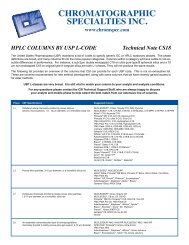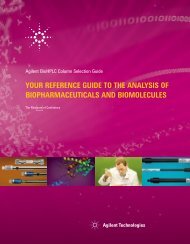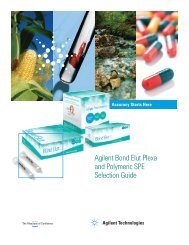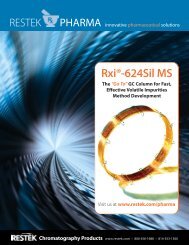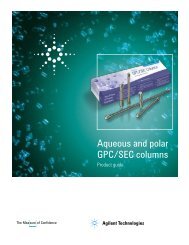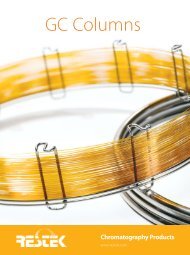Optimizing the Analysis of Volatile Organic Compounds
Optimizing the Analysis of Volatile Organic Compounds
Optimizing the Analysis of Volatile Organic Compounds
Create successful ePaper yourself
Turn your PDF publications into a flip-book with our unique Google optimized e-Paper software.
Connect <strong>the</strong> capillary column, 0.25mm ID or smaller, to <strong>the</strong> injection port, but not to <strong>the</strong><br />
MS source, and condition <strong>the</strong> column. When <strong>the</strong> column has been conditioned, remove<br />
50cm from <strong>the</strong> detector end <strong>of</strong> <strong>the</strong> column to ensure complete removal <strong>of</strong> siloxanes and<br />
o<strong>the</strong>r potential contaminants. Then, with <strong>the</strong> MS still turned <strong>of</strong>f, insert <strong>the</strong> column end into<br />
<strong>the</strong> MS source. Cut <strong>the</strong> column several centimeters from <strong>the</strong> connection to <strong>the</strong> injection port.<br />
Use septa to cap <strong>the</strong> short length <strong>of</strong> column that is left in <strong>the</strong> injection port and <strong>the</strong> new,<br />
unconnected inlet end <strong>of</strong> <strong>the</strong> column. Also cap <strong>the</strong> split vent and septum purge vent lines on<br />
<strong>the</strong> GC (Figure 38). Perform a pressure decay test on <strong>the</strong> injection port by setting <strong>the</strong> pressure<br />
to 30psi, <strong>the</strong>n shutting <strong>of</strong>f <strong>the</strong> gas supply. The pressure should remain constant for at<br />
least 1 minute. If <strong>the</strong> pressure drops in less than 1 minute, turn on <strong>the</strong> gas supply and begin<br />
leak checking, using an electronic leak detector, such as <strong>the</strong> Restek Leak Detective TM II (cat.<br />
#20413, page 36).<br />
Once you have confirmed <strong>the</strong> GC system is leak-tight, and while <strong>the</strong> injection port end <strong>of</strong><br />
<strong>the</strong> column is capped and <strong>the</strong>re is no flow in <strong>the</strong> column, evacuate <strong>the</strong> MS and record <strong>the</strong><br />
source pressure in your maintenance logbook. After several hours equilibration, perform <strong>the</strong><br />
instrument leak-check using PFTBA (see MS Calibration and Tuning, page 32). If a leak is<br />
present, draw 500µL <strong>of</strong> methanol into a syringe and apply drops <strong>of</strong> this solvent on areas<br />
where leaks might be suspected, while scanning for mass 31. Alternatively, ba<strong>the</strong> <strong>the</strong>se areas<br />
with argon gas and scan for m/z 40. The brass source nut is <strong>the</strong> primary place for leaks in an<br />
MS, this nut should be replaced every time <strong>the</strong> column is changed (cat. #20643, page 35).<br />
O<strong>the</strong>r areas to examine include <strong>the</strong> rubber seals and <strong>the</strong> PFTBA vial.<br />
After you confirm <strong>the</strong> MS is leak-free, quickly install <strong>the</strong> inlet end <strong>of</strong> <strong>the</strong> column into <strong>the</strong><br />
injection port. The MS will draw air into <strong>the</strong> source during this connection time; after ano<strong>the</strong>r<br />
2-hour equilibration <strong>the</strong> MS is ready for tuning/leak checking using PFTBA.<br />
Figure 37.<br />
Cl and Br are examples <strong>of</strong> A+2 elements (isotopes vary by 2amu or more).<br />
Cl Cl2 Br<br />
Br2<br />
Element Mass % Abundance Mass % Abundance<br />
carbon 12 100 13 1.1<br />
nitrogen 14 100 15 0.37<br />
chlorine 35 100 37 32.5<br />
bromine 79 100 81 98<br />
oxygen 16 100 18 0.2<br />
Table V.<br />
Fragment ions can <strong>of</strong>fer clues to compound composition.<br />
Compound Class Fragment Ions<br />
Aldehydes, amides, amines 44, 58, 72, 59, 30<br />
Aliphatic hydrocarbons 43, 57, 71, 85, 99<br />
Alkylbenzenes 104, 91<br />
Aromatic hydrocarbons 39, 50, 51, 52, 63, 65, 76, 77, 91<br />
Fluorine-containing 50, 69<br />
Methacrylates 41, 69<br />
Methyl ketones 43, 58<br />
Oxygen-containing 31,45,59,73<br />
Sulfur-containing 47,61<br />
Unsaturated hydrocarbons 41, 55, 69<br />
35<br />
Figure 38.<br />
To check for leaks, cap <strong>the</strong> split vent and<br />
septum purge vent lines on <strong>the</strong> GC and <strong>the</strong><br />
column, <strong>the</strong>n shut <strong>of</strong>f <strong>the</strong> gas supply.<br />
System pressure should remain constant.<br />
Cap both<br />
MSD Source Nut<br />
(Similar to Agilent part # 05988-20066.)<br />
Description qty. cat.#<br />
(Detector) MSD Source Nut 2-pk. 20643<br />
www.restekcorp.com





